University Report: Managing Product Service and Innovation
VerifiedAdded on 2023/01/04
|18
|5190
|1
Report
AI Summary
This report provides a detailed analysis of product service and innovation, with a specific focus on new product development (NPD). It begins with an introduction to the concept of NPD and its importance in today's dynamic market, emphasizing the need for organizations to adapt to changing consumer preferences and technological advancements. The report then explores various factors affecting NPD, categorized into product-related (pricing, uniqueness) and market-related (target market concentration, market competitiveness) aspects, with Coca-Cola serving as a case study. Further, the report delves into critical success factors and identifies strengths and weaknesses within the context of the chosen organization. Finally, it offers actionable recommendations for enhancing NPD practices, supported by relevant literature and the earlier analysis, aiming to improve the organization's ability to introduce successful new products and services.
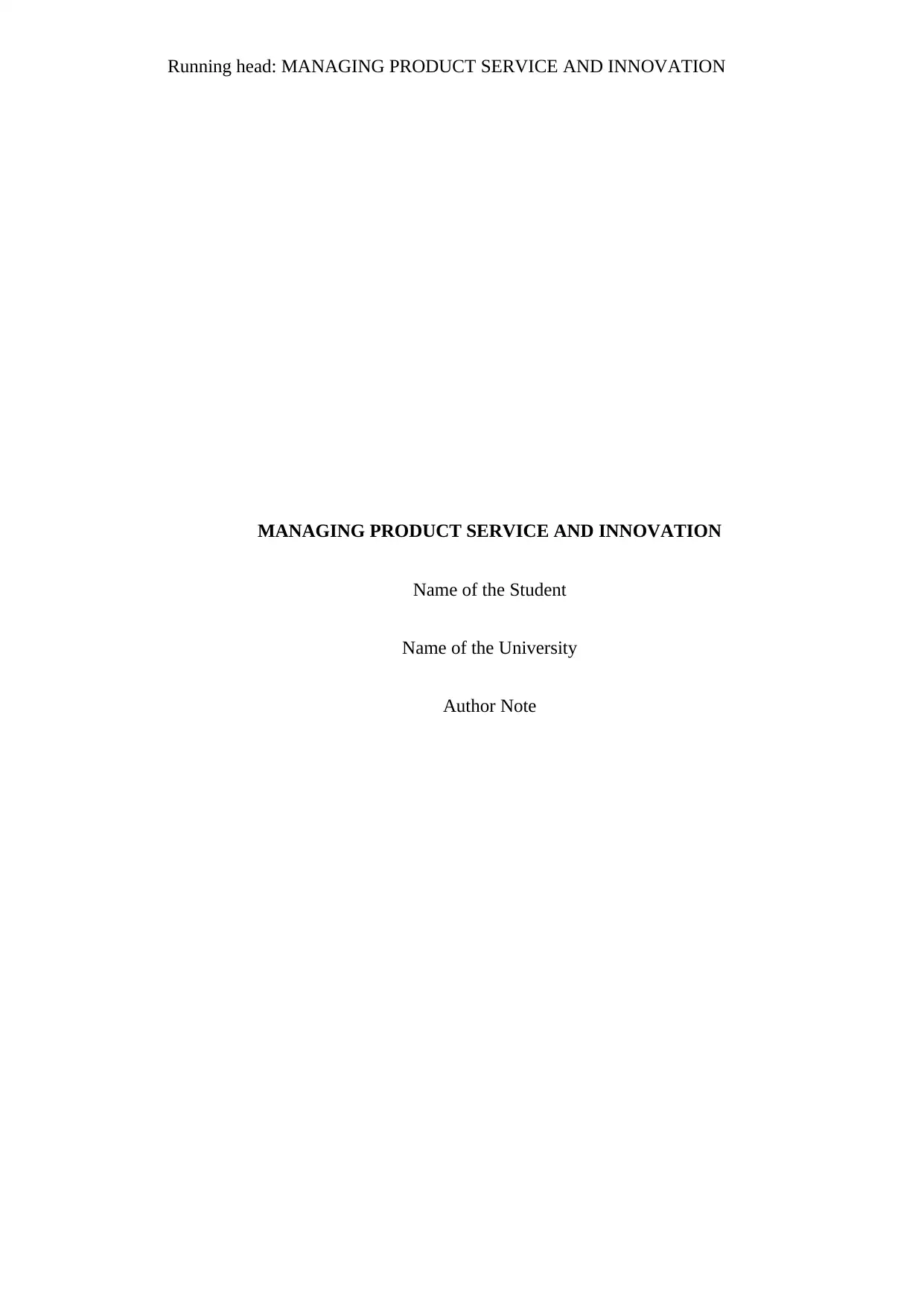
Running head: MANAGING PRODUCT SERVICE AND INNOVATION
MANAGING PRODUCT SERVICE AND INNOVATION
Name of the Student
Name of the University
Author Note
MANAGING PRODUCT SERVICE AND INNOVATION
Name of the Student
Name of the University
Author Note
Paraphrase This Document
Need a fresh take? Get an instant paraphrase of this document with our AI Paraphraser
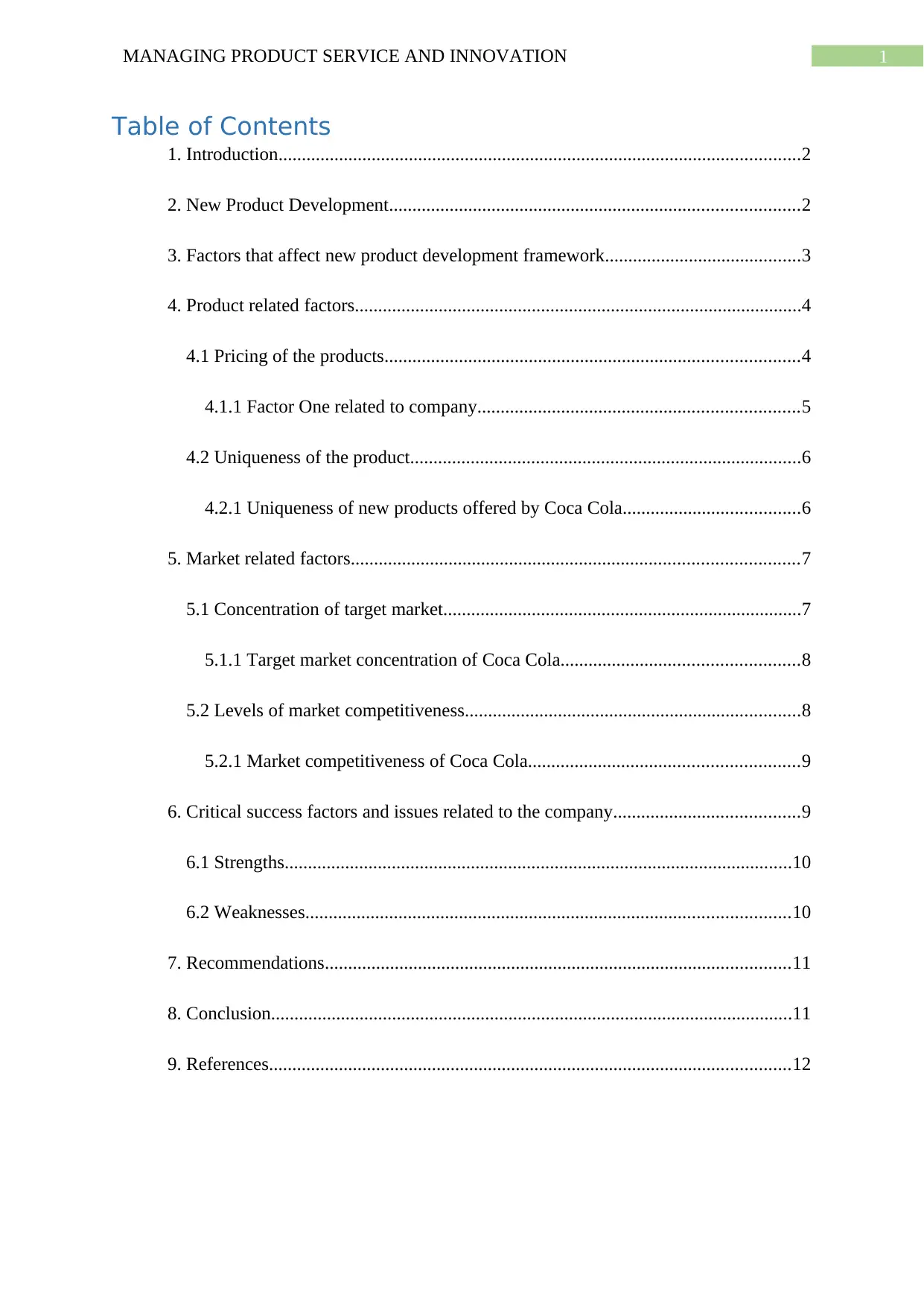
1MANAGING PRODUCT SERVICE AND INNOVATION
Table of Contents
1. Introduction................................................................................................................2
2. New Product Development........................................................................................2
3. Factors that affect new product development framework..........................................3
4. Product related factors................................................................................................4
4.1 Pricing of the products.........................................................................................4
4.1.1 Factor One related to company.....................................................................5
4.2 Uniqueness of the product....................................................................................6
4.2.1 Uniqueness of new products offered by Coca Cola......................................6
5. Market related factors................................................................................................7
5.1 Concentration of target market.............................................................................7
5.1.1 Target market concentration of Coca Cola...................................................8
5.2 Levels of market competitiveness........................................................................8
5.2.1 Market competitiveness of Coca Cola..........................................................9
6. Critical success factors and issues related to the company........................................9
6.1 Strengths.............................................................................................................10
6.2 Weaknesses........................................................................................................10
7. Recommendations....................................................................................................11
8. Conclusion................................................................................................................11
9. References................................................................................................................12
Table of Contents
1. Introduction................................................................................................................2
2. New Product Development........................................................................................2
3. Factors that affect new product development framework..........................................3
4. Product related factors................................................................................................4
4.1 Pricing of the products.........................................................................................4
4.1.1 Factor One related to company.....................................................................5
4.2 Uniqueness of the product....................................................................................6
4.2.1 Uniqueness of new products offered by Coca Cola......................................6
5. Market related factors................................................................................................7
5.1 Concentration of target market.............................................................................7
5.1.1 Target market concentration of Coca Cola...................................................8
5.2 Levels of market competitiveness........................................................................8
5.2.1 Market competitiveness of Coca Cola..........................................................9
6. Critical success factors and issues related to the company........................................9
6.1 Strengths.............................................................................................................10
6.2 Weaknesses........................................................................................................10
7. Recommendations....................................................................................................11
8. Conclusion................................................................................................................11
9. References................................................................................................................12
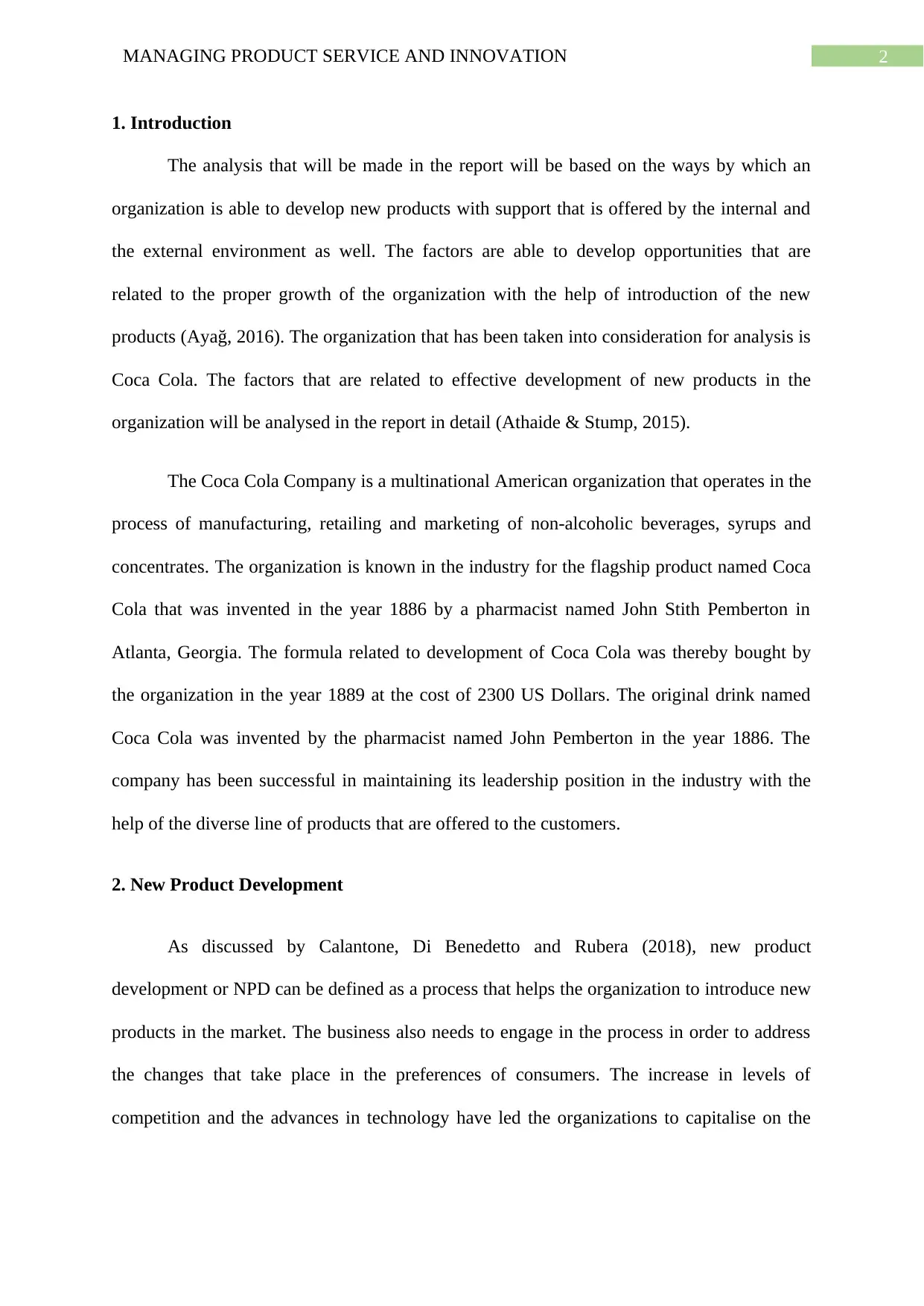
2MANAGING PRODUCT SERVICE AND INNOVATION
1. Introduction
The analysis that will be made in the report will be based on the ways by which an
organization is able to develop new products with support that is offered by the internal and
the external environment as well. The factors are able to develop opportunities that are
related to the proper growth of the organization with the help of introduction of the new
products (Ayağ, 2016). The organization that has been taken into consideration for analysis is
Coca Cola. The factors that are related to effective development of new products in the
organization will be analysed in the report in detail (Athaide & Stump, 2015).
The Coca Cola Company is a multinational American organization that operates in the
process of manufacturing, retailing and marketing of non-alcoholic beverages, syrups and
concentrates. The organization is known in the industry for the flagship product named Coca
Cola that was invented in the year 1886 by a pharmacist named John Stith Pemberton in
Atlanta, Georgia. The formula related to development of Coca Cola was thereby bought by
the organization in the year 1889 at the cost of 2300 US Dollars. The original drink named
Coca Cola was invented by the pharmacist named John Pemberton in the year 1886. The
company has been successful in maintaining its leadership position in the industry with the
help of the diverse line of products that are offered to the customers.
2. New Product Development
As discussed by Calantone, Di Benedetto and Rubera (2018), new product
development or NPD can be defined as a process that helps the organization to introduce new
products in the market. The business also needs to engage in the process in order to address
the changes that take place in the preferences of consumers. The increase in levels of
competition and the advances in technology have led the organizations to capitalise on the
1. Introduction
The analysis that will be made in the report will be based on the ways by which an
organization is able to develop new products with support that is offered by the internal and
the external environment as well. The factors are able to develop opportunities that are
related to the proper growth of the organization with the help of introduction of the new
products (Ayağ, 2016). The organization that has been taken into consideration for analysis is
Coca Cola. The factors that are related to effective development of new products in the
organization will be analysed in the report in detail (Athaide & Stump, 2015).
The Coca Cola Company is a multinational American organization that operates in the
process of manufacturing, retailing and marketing of non-alcoholic beverages, syrups and
concentrates. The organization is known in the industry for the flagship product named Coca
Cola that was invented in the year 1886 by a pharmacist named John Stith Pemberton in
Atlanta, Georgia. The formula related to development of Coca Cola was thereby bought by
the organization in the year 1889 at the cost of 2300 US Dollars. The original drink named
Coca Cola was invented by the pharmacist named John Pemberton in the year 1886. The
company has been successful in maintaining its leadership position in the industry with the
help of the diverse line of products that are offered to the customers.
2. New Product Development
As discussed by Calantone, Di Benedetto and Rubera (2018), new product
development or NPD can be defined as a process that helps the organization to introduce new
products in the market. The business also needs to engage in the process in order to address
the changes that take place in the preferences of consumers. The increase in levels of
competition and the advances in technology have led the organizations to capitalise on the
⊘ This is a preview!⊘
Do you want full access?
Subscribe today to unlock all pages.

Trusted by 1+ million students worldwide
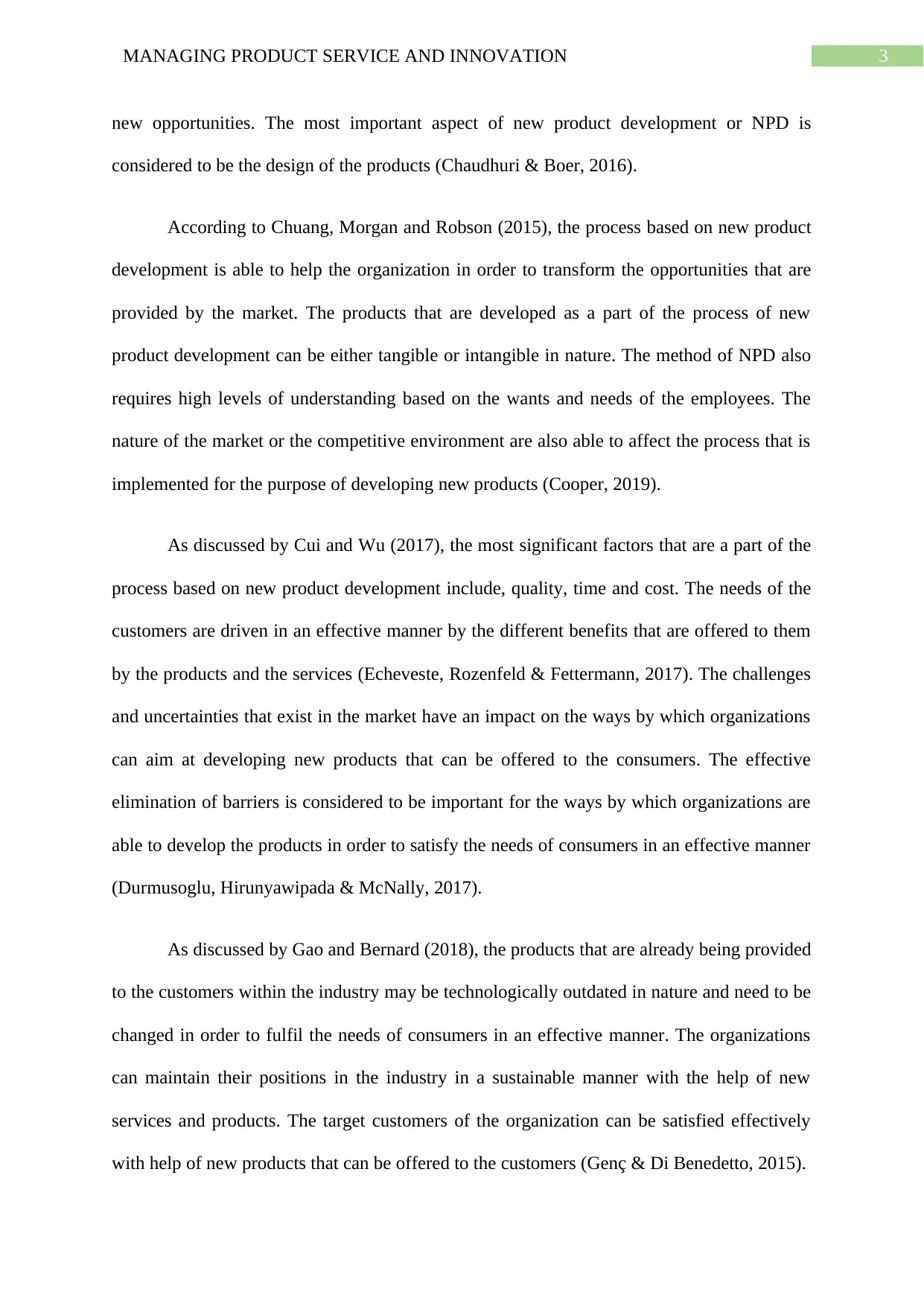
3MANAGING PRODUCT SERVICE AND INNOVATION
new opportunities. The most important aspect of new product development or NPD is
considered to be the design of the products (Chaudhuri & Boer, 2016).
According to Chuang, Morgan and Robson (2015), the process based on new product
development is able to help the organization in order to transform the opportunities that are
provided by the market. The products that are developed as a part of the process of new
product development can be either tangible or intangible in nature. The method of NPD also
requires high levels of understanding based on the wants and needs of the employees. The
nature of the market or the competitive environment are also able to affect the process that is
implemented for the purpose of developing new products (Cooper, 2019).
As discussed by Cui and Wu (2017), the most significant factors that are a part of the
process based on new product development include, quality, time and cost. The needs of the
customers are driven in an effective manner by the different benefits that are offered to them
by the products and the services (Echeveste, Rozenfeld & Fettermann, 2017). The challenges
and uncertainties that exist in the market have an impact on the ways by which organizations
can aim at developing new products that can be offered to the consumers. The effective
elimination of barriers is considered to be important for the ways by which organizations are
able to develop the products in order to satisfy the needs of consumers in an effective manner
(Durmusoglu, Hirunyawipada & McNally, 2017).
As discussed by Gao and Bernard (2018), the products that are already being provided
to the customers within the industry may be technologically outdated in nature and need to be
changed in order to fulfil the needs of consumers in an effective manner. The organizations
can maintain their positions in the industry in a sustainable manner with the help of new
services and products. The target customers of the organization can be satisfied effectively
with help of new products that can be offered to the customers (Genç & Di Benedetto, 2015).
new opportunities. The most important aspect of new product development or NPD is
considered to be the design of the products (Chaudhuri & Boer, 2016).
According to Chuang, Morgan and Robson (2015), the process based on new product
development is able to help the organization in order to transform the opportunities that are
provided by the market. The products that are developed as a part of the process of new
product development can be either tangible or intangible in nature. The method of NPD also
requires high levels of understanding based on the wants and needs of the employees. The
nature of the market or the competitive environment are also able to affect the process that is
implemented for the purpose of developing new products (Cooper, 2019).
As discussed by Cui and Wu (2017), the most significant factors that are a part of the
process based on new product development include, quality, time and cost. The needs of the
customers are driven in an effective manner by the different benefits that are offered to them
by the products and the services (Echeveste, Rozenfeld & Fettermann, 2017). The challenges
and uncertainties that exist in the market have an impact on the ways by which organizations
can aim at developing new products that can be offered to the consumers. The effective
elimination of barriers is considered to be important for the ways by which organizations are
able to develop the products in order to satisfy the needs of consumers in an effective manner
(Durmusoglu, Hirunyawipada & McNally, 2017).
As discussed by Gao and Bernard (2018), the products that are already being provided
to the customers within the industry may be technologically outdated in nature and need to be
changed in order to fulfil the needs of consumers in an effective manner. The organizations
can maintain their positions in the industry in a sustainable manner with the help of new
services and products. The target customers of the organization can be satisfied effectively
with help of new products that can be offered to the customers (Genç & Di Benedetto, 2015).
Paraphrase This Document
Need a fresh take? Get an instant paraphrase of this document with our AI Paraphraser
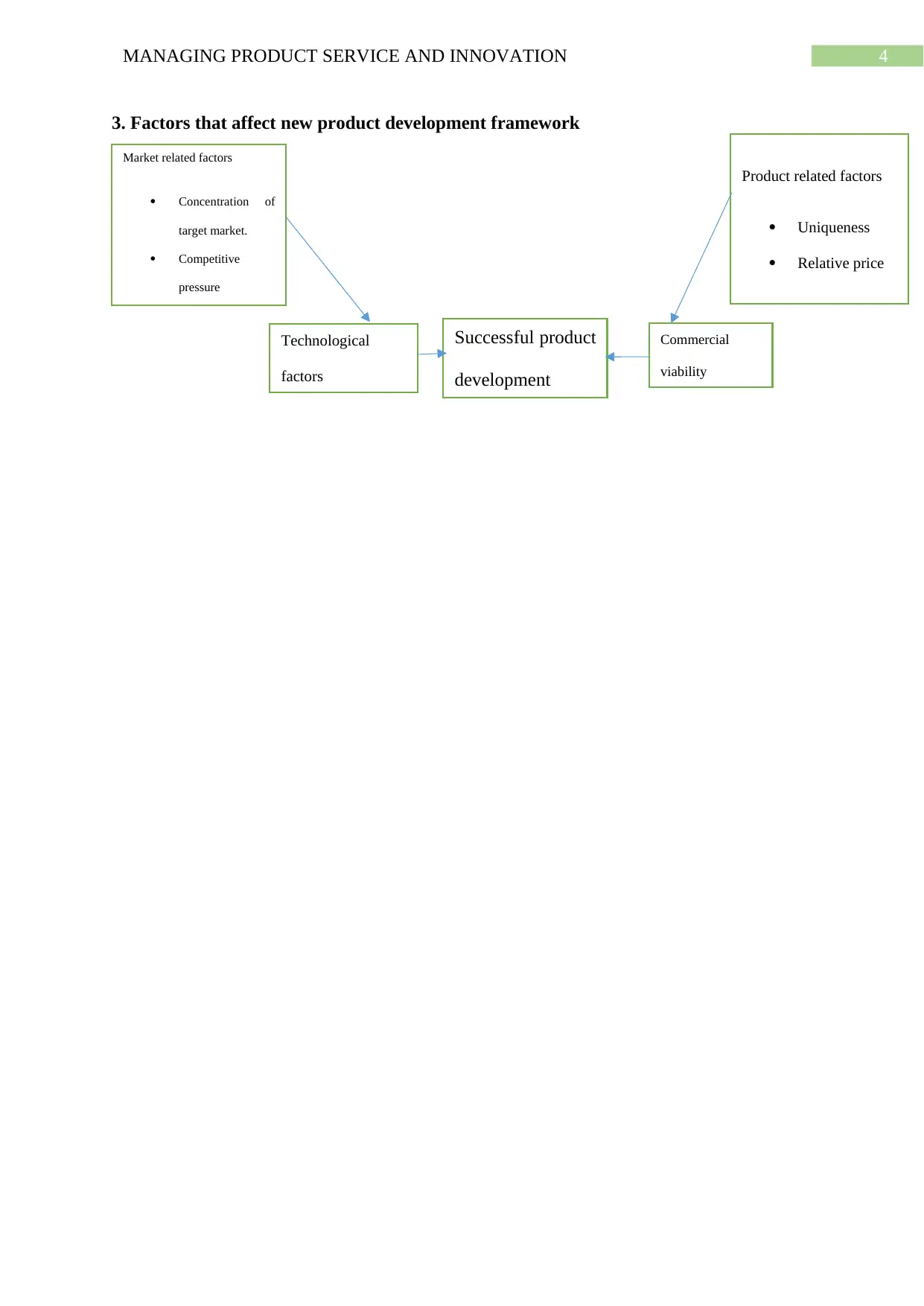
4MANAGING PRODUCT SERVICE AND INNOVATION
3. Factors that affect new product development framework
Successful product
development
Commercial
viability
Technological
factors
Market related factors
Concentration of
target market.
Competitive
pressure
Product related factors
Uniqueness
Relative price
3. Factors that affect new product development framework
Successful product
development
Commercial
viability
Technological
factors
Market related factors
Concentration of
target market.
Competitive
pressure
Product related factors
Uniqueness
Relative price
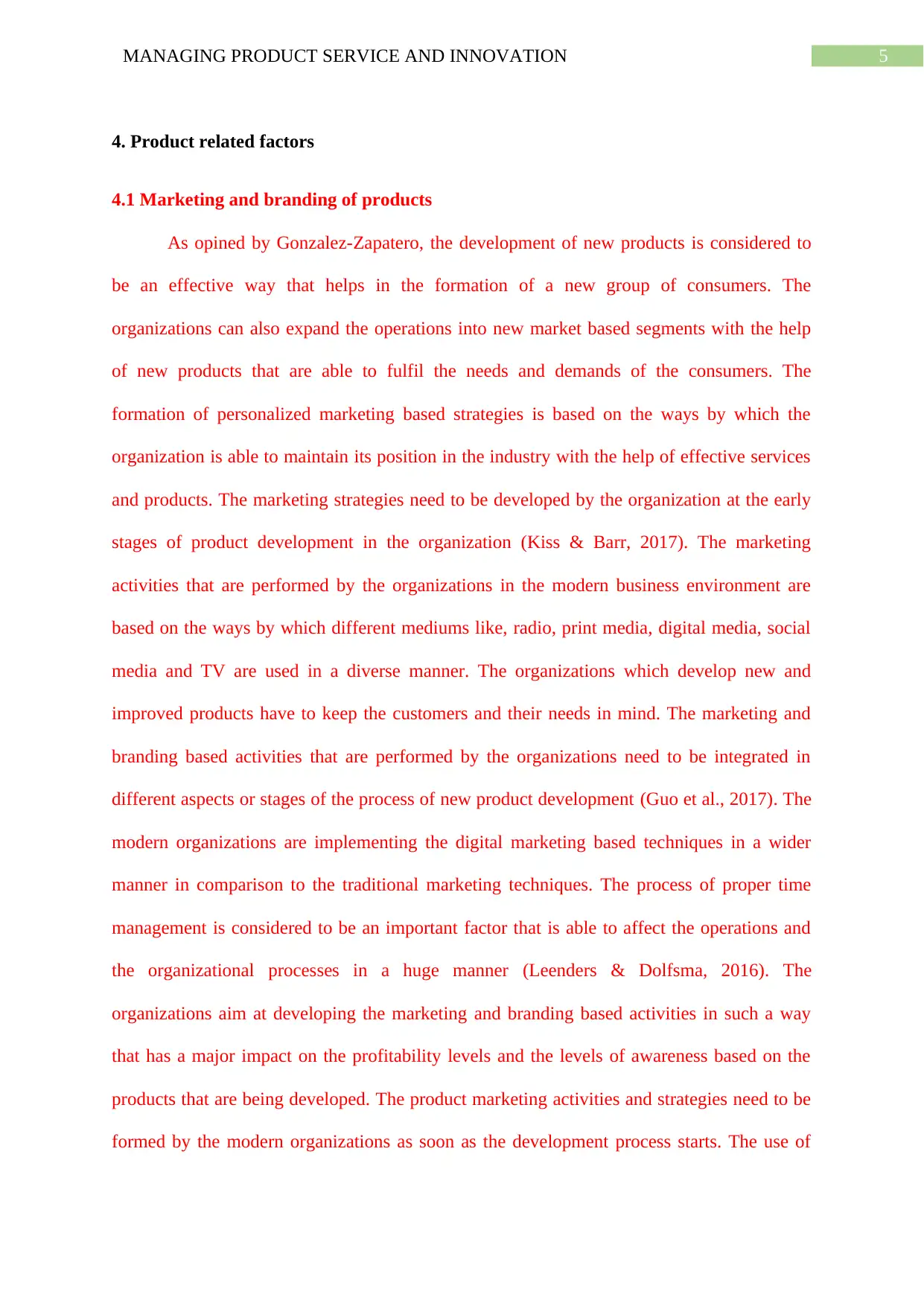
5MANAGING PRODUCT SERVICE AND INNOVATION
4. Product related factors
4.1 Marketing and branding of products
As opined by Gonzalez-Zapatero, the development of new products is considered to
be an effective way that helps in the formation of a new group of consumers. The
organizations can also expand the operations into new market based segments with the help
of new products that are able to fulfil the needs and demands of the consumers. The
formation of personalized marketing based strategies is based on the ways by which the
organization is able to maintain its position in the industry with the help of effective services
and products. The marketing strategies need to be developed by the organization at the early
stages of product development in the organization (Kiss & Barr, 2017). The marketing
activities that are performed by the organizations in the modern business environment are
based on the ways by which different mediums like, radio, print media, digital media, social
media and TV are used in a diverse manner. The organizations which develop new and
improved products have to keep the customers and their needs in mind. The marketing and
branding based activities that are performed by the organizations need to be integrated in
different aspects or stages of the process of new product development (Guo et al., 2017). The
modern organizations are implementing the digital marketing based techniques in a wider
manner in comparison to the traditional marketing techniques. The process of proper time
management is considered to be an important factor that is able to affect the operations and
the organizational processes in a huge manner (Leenders & Dolfsma, 2016). The
organizations aim at developing the marketing and branding based activities in such a way
that has a major impact on the profitability levels and the levels of awareness based on the
products that are being developed. The product marketing activities and strategies need to be
formed by the modern organizations as soon as the development process starts. The use of
4. Product related factors
4.1 Marketing and branding of products
As opined by Gonzalez-Zapatero, the development of new products is considered to
be an effective way that helps in the formation of a new group of consumers. The
organizations can also expand the operations into new market based segments with the help
of new products that are able to fulfil the needs and demands of the consumers. The
formation of personalized marketing based strategies is based on the ways by which the
organization is able to maintain its position in the industry with the help of effective services
and products. The marketing strategies need to be developed by the organization at the early
stages of product development in the organization (Kiss & Barr, 2017). The marketing
activities that are performed by the organizations in the modern business environment are
based on the ways by which different mediums like, radio, print media, digital media, social
media and TV are used in a diverse manner. The organizations which develop new and
improved products have to keep the customers and their needs in mind. The marketing and
branding based activities that are performed by the organizations need to be integrated in
different aspects or stages of the process of new product development (Guo et al., 2017). The
modern organizations are implementing the digital marketing based techniques in a wider
manner in comparison to the traditional marketing techniques. The process of proper time
management is considered to be an important factor that is able to affect the operations and
the organizational processes in a huge manner (Leenders & Dolfsma, 2016). The
organizations aim at developing the marketing and branding based activities in such a way
that has a major impact on the profitability levels and the levels of awareness based on the
products that are being developed. The product marketing activities and strategies need to be
formed by the modern organizations as soon as the development process starts. The use of
⊘ This is a preview!⊘
Do you want full access?
Subscribe today to unlock all pages.

Trusted by 1+ million students worldwide
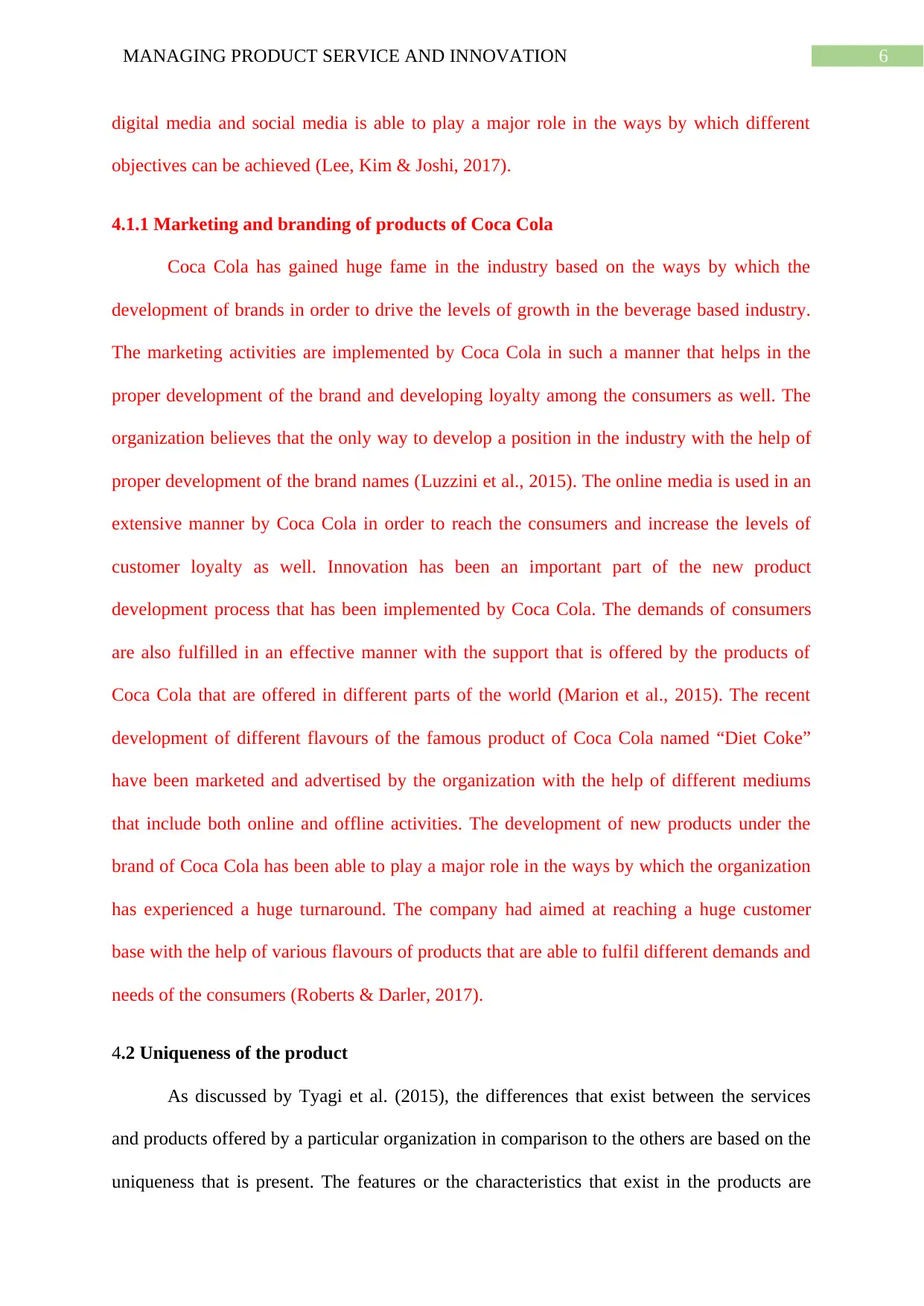
6MANAGING PRODUCT SERVICE AND INNOVATION
digital media and social media is able to play a major role in the ways by which different
objectives can be achieved (Lee, Kim & Joshi, 2017).
4.1.1 Marketing and branding of products of Coca Cola
Coca Cola has gained huge fame in the industry based on the ways by which the
development of brands in order to drive the levels of growth in the beverage based industry.
The marketing activities are implemented by Coca Cola in such a manner that helps in the
proper development of the brand and developing loyalty among the consumers as well. The
organization believes that the only way to develop a position in the industry with the help of
proper development of the brand names (Luzzini et al., 2015). The online media is used in an
extensive manner by Coca Cola in order to reach the consumers and increase the levels of
customer loyalty as well. Innovation has been an important part of the new product
development process that has been implemented by Coca Cola. The demands of consumers
are also fulfilled in an effective manner with the support that is offered by the products of
Coca Cola that are offered in different parts of the world (Marion et al., 2015). The recent
development of different flavours of the famous product of Coca Cola named “Diet Coke”
have been marketed and advertised by the organization with the help of different mediums
that include both online and offline activities. The development of new products under the
brand of Coca Cola has been able to play a major role in the ways by which the organization
has experienced a huge turnaround. The company had aimed at reaching a huge customer
base with the help of various flavours of products that are able to fulfil different demands and
needs of the consumers (Roberts & Darler, 2017).
4.2 Uniqueness of the product
As discussed by Tyagi et al. (2015), the differences that exist between the services
and products offered by a particular organization in comparison to the others are based on the
uniqueness that is present. The features or the characteristics that exist in the products are
digital media and social media is able to play a major role in the ways by which different
objectives can be achieved (Lee, Kim & Joshi, 2017).
4.1.1 Marketing and branding of products of Coca Cola
Coca Cola has gained huge fame in the industry based on the ways by which the
development of brands in order to drive the levels of growth in the beverage based industry.
The marketing activities are implemented by Coca Cola in such a manner that helps in the
proper development of the brand and developing loyalty among the consumers as well. The
organization believes that the only way to develop a position in the industry with the help of
proper development of the brand names (Luzzini et al., 2015). The online media is used in an
extensive manner by Coca Cola in order to reach the consumers and increase the levels of
customer loyalty as well. Innovation has been an important part of the new product
development process that has been implemented by Coca Cola. The demands of consumers
are also fulfilled in an effective manner with the support that is offered by the products of
Coca Cola that are offered in different parts of the world (Marion et al., 2015). The recent
development of different flavours of the famous product of Coca Cola named “Diet Coke”
have been marketed and advertised by the organization with the help of different mediums
that include both online and offline activities. The development of new products under the
brand of Coca Cola has been able to play a major role in the ways by which the organization
has experienced a huge turnaround. The company had aimed at reaching a huge customer
base with the help of various flavours of products that are able to fulfil different demands and
needs of the consumers (Roberts & Darler, 2017).
4.2 Uniqueness of the product
As discussed by Tyagi et al. (2015), the differences that exist between the services
and products offered by a particular organization in comparison to the others are based on the
uniqueness that is present. The features or the characteristics that exist in the products are
Paraphrase This Document
Need a fresh take? Get an instant paraphrase of this document with our AI Paraphraser
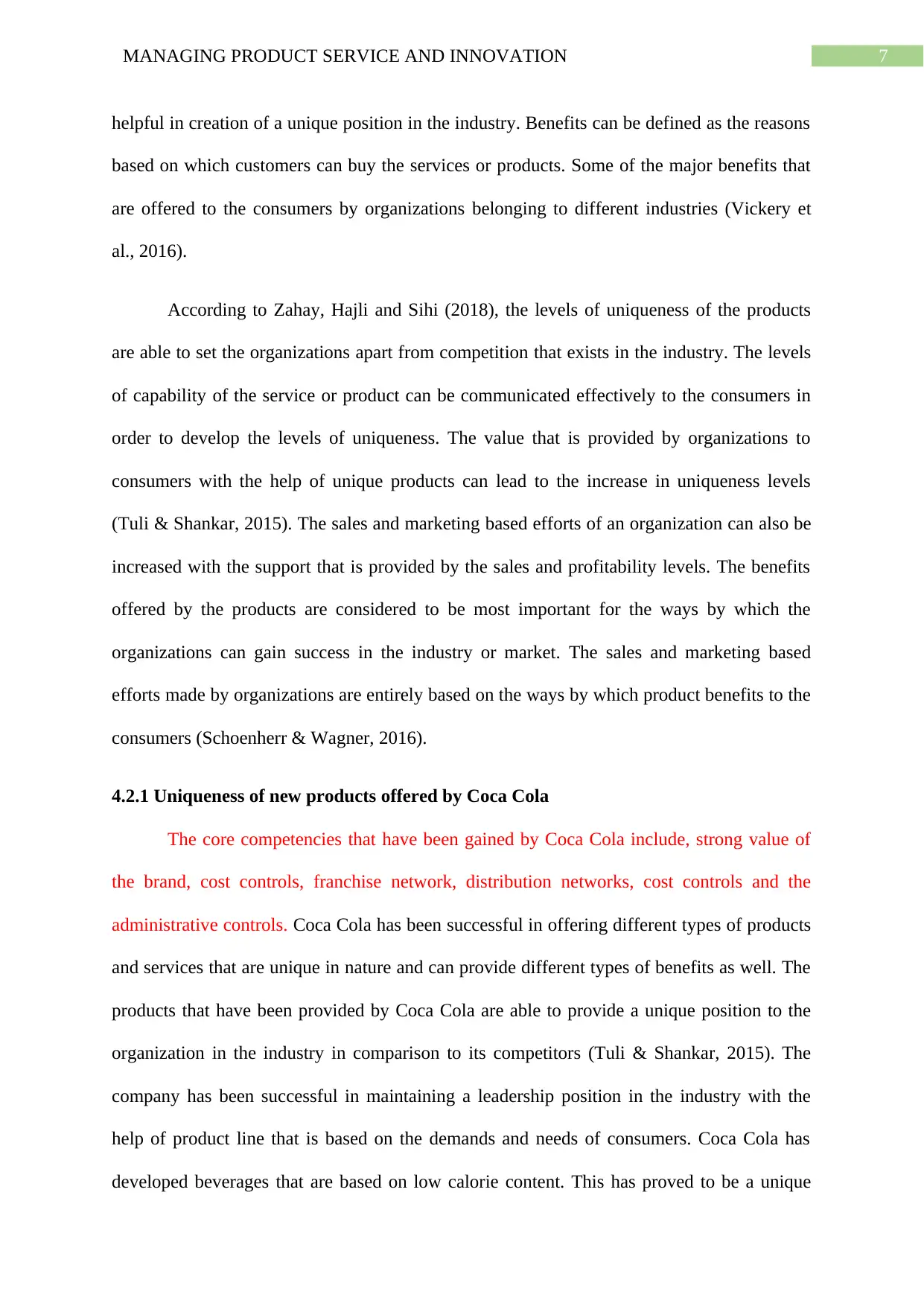
7MANAGING PRODUCT SERVICE AND INNOVATION
helpful in creation of a unique position in the industry. Benefits can be defined as the reasons
based on which customers can buy the services or products. Some of the major benefits that
are offered to the consumers by organizations belonging to different industries (Vickery et
al., 2016).
According to Zahay, Hajli and Sihi (2018), the levels of uniqueness of the products
are able to set the organizations apart from competition that exists in the industry. The levels
of capability of the service or product can be communicated effectively to the consumers in
order to develop the levels of uniqueness. The value that is provided by organizations to
consumers with the help of unique products can lead to the increase in uniqueness levels
(Tuli & Shankar, 2015). The sales and marketing based efforts of an organization can also be
increased with the support that is provided by the sales and profitability levels. The benefits
offered by the products are considered to be most important for the ways by which the
organizations can gain success in the industry or market. The sales and marketing based
efforts made by organizations are entirely based on the ways by which product benefits to the
consumers (Schoenherr & Wagner, 2016).
4.2.1 Uniqueness of new products offered by Coca Cola
The core competencies that have been gained by Coca Cola include, strong value of
the brand, cost controls, franchise network, distribution networks, cost controls and the
administrative controls. Coca Cola has been successful in offering different types of products
and services that are unique in nature and can provide different types of benefits as well. The
products that have been provided by Coca Cola are able to provide a unique position to the
organization in the industry in comparison to its competitors (Tuli & Shankar, 2015). The
company has been successful in maintaining a leadership position in the industry with the
help of product line that is based on the demands and needs of consumers. Coca Cola has
developed beverages that are based on low calorie content. This has proved to be a unique
helpful in creation of a unique position in the industry. Benefits can be defined as the reasons
based on which customers can buy the services or products. Some of the major benefits that
are offered to the consumers by organizations belonging to different industries (Vickery et
al., 2016).
According to Zahay, Hajli and Sihi (2018), the levels of uniqueness of the products
are able to set the organizations apart from competition that exists in the industry. The levels
of capability of the service or product can be communicated effectively to the consumers in
order to develop the levels of uniqueness. The value that is provided by organizations to
consumers with the help of unique products can lead to the increase in uniqueness levels
(Tuli & Shankar, 2015). The sales and marketing based efforts of an organization can also be
increased with the support that is provided by the sales and profitability levels. The benefits
offered by the products are considered to be most important for the ways by which the
organizations can gain success in the industry or market. The sales and marketing based
efforts made by organizations are entirely based on the ways by which product benefits to the
consumers (Schoenherr & Wagner, 2016).
4.2.1 Uniqueness of new products offered by Coca Cola
The core competencies that have been gained by Coca Cola include, strong value of
the brand, cost controls, franchise network, distribution networks, cost controls and the
administrative controls. Coca Cola has been successful in offering different types of products
and services that are unique in nature and can provide different types of benefits as well. The
products that have been provided by Coca Cola are able to provide a unique position to the
organization in the industry in comparison to its competitors (Tuli & Shankar, 2015). The
company has been successful in maintaining a leadership position in the industry with the
help of product line that is based on the demands and needs of consumers. Coca Cola has
developed beverages that are based on low calorie content. This has proved to be a unique
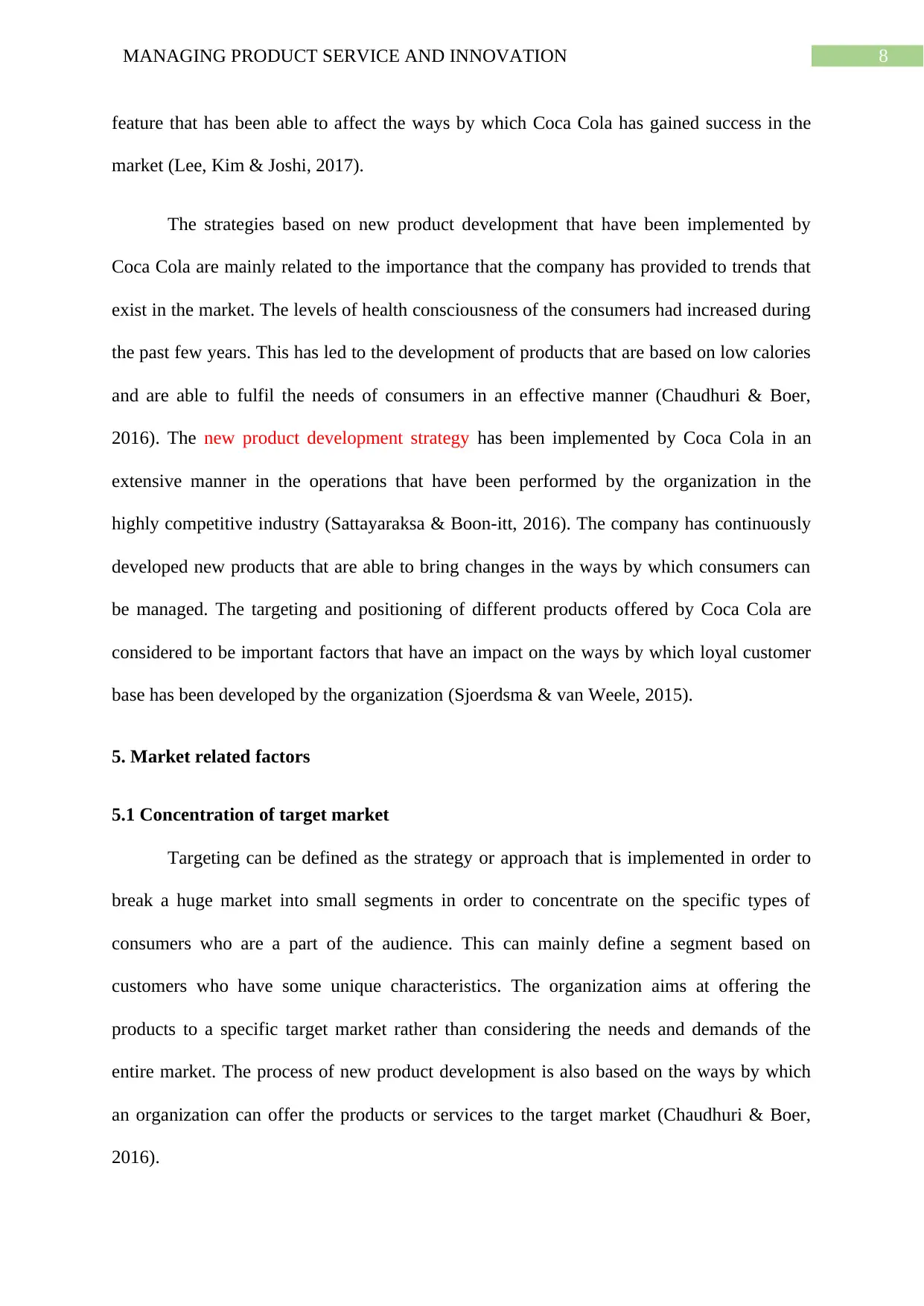
8MANAGING PRODUCT SERVICE AND INNOVATION
feature that has been able to affect the ways by which Coca Cola has gained success in the
market (Lee, Kim & Joshi, 2017).
The strategies based on new product development that have been implemented by
Coca Cola are mainly related to the importance that the company has provided to trends that
exist in the market. The levels of health consciousness of the consumers had increased during
the past few years. This has led to the development of products that are based on low calories
and are able to fulfil the needs of consumers in an effective manner (Chaudhuri & Boer,
2016). The new product development strategy has been implemented by Coca Cola in an
extensive manner in the operations that have been performed by the organization in the
highly competitive industry (Sattayaraksa & Boon-itt, 2016). The company has continuously
developed new products that are able to bring changes in the ways by which consumers can
be managed. The targeting and positioning of different products offered by Coca Cola are
considered to be important factors that have an impact on the ways by which loyal customer
base has been developed by the organization (Sjoerdsma & van Weele, 2015).
5. Market related factors
5.1 Concentration of target market
Targeting can be defined as the strategy or approach that is implemented in order to
break a huge market into small segments in order to concentrate on the specific types of
consumers who are a part of the audience. This can mainly define a segment based on
customers who have some unique characteristics. The organization aims at offering the
products to a specific target market rather than considering the needs and demands of the
entire market. The process of new product development is also based on the ways by which
an organization can offer the products or services to the target market (Chaudhuri & Boer,
2016).
feature that has been able to affect the ways by which Coca Cola has gained success in the
market (Lee, Kim & Joshi, 2017).
The strategies based on new product development that have been implemented by
Coca Cola are mainly related to the importance that the company has provided to trends that
exist in the market. The levels of health consciousness of the consumers had increased during
the past few years. This has led to the development of products that are based on low calories
and are able to fulfil the needs of consumers in an effective manner (Chaudhuri & Boer,
2016). The new product development strategy has been implemented by Coca Cola in an
extensive manner in the operations that have been performed by the organization in the
highly competitive industry (Sattayaraksa & Boon-itt, 2016). The company has continuously
developed new products that are able to bring changes in the ways by which consumers can
be managed. The targeting and positioning of different products offered by Coca Cola are
considered to be important factors that have an impact on the ways by which loyal customer
base has been developed by the organization (Sjoerdsma & van Weele, 2015).
5. Market related factors
5.1 Concentration of target market
Targeting can be defined as the strategy or approach that is implemented in order to
break a huge market into small segments in order to concentrate on the specific types of
consumers who are a part of the audience. This can mainly define a segment based on
customers who have some unique characteristics. The organization aims at offering the
products to a specific target market rather than considering the needs and demands of the
entire market. The process of new product development is also based on the ways by which
an organization can offer the products or services to the target market (Chaudhuri & Boer,
2016).
⊘ This is a preview!⊘
Do you want full access?
Subscribe today to unlock all pages.

Trusted by 1+ million students worldwide
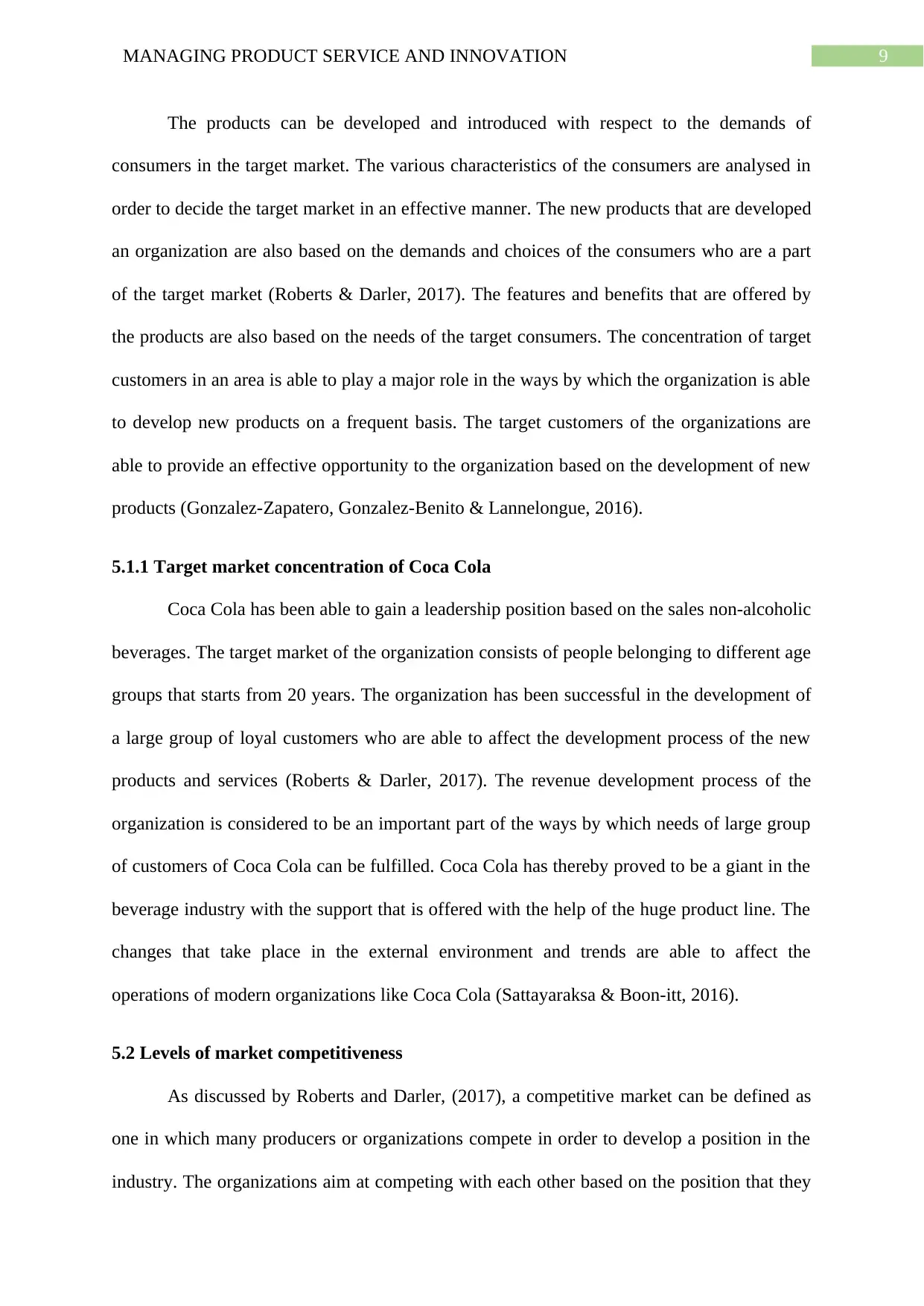
9MANAGING PRODUCT SERVICE AND INNOVATION
The products can be developed and introduced with respect to the demands of
consumers in the target market. The various characteristics of the consumers are analysed in
order to decide the target market in an effective manner. The new products that are developed
an organization are also based on the demands and choices of the consumers who are a part
of the target market (Roberts & Darler, 2017). The features and benefits that are offered by
the products are also based on the needs of the target consumers. The concentration of target
customers in an area is able to play a major role in the ways by which the organization is able
to develop new products on a frequent basis. The target customers of the organizations are
able to provide an effective opportunity to the organization based on the development of new
products (Gonzalez-Zapatero, Gonzalez-Benito & Lannelongue, 2016).
5.1.1 Target market concentration of Coca Cola
Coca Cola has been able to gain a leadership position based on the sales non-alcoholic
beverages. The target market of the organization consists of people belonging to different age
groups that starts from 20 years. The organization has been successful in the development of
a large group of loyal customers who are able to affect the development process of the new
products and services (Roberts & Darler, 2017). The revenue development process of the
organization is considered to be an important part of the ways by which needs of large group
of customers of Coca Cola can be fulfilled. Coca Cola has thereby proved to be a giant in the
beverage industry with the support that is offered with the help of the huge product line. The
changes that take place in the external environment and trends are able to affect the
operations of modern organizations like Coca Cola (Sattayaraksa & Boon-itt, 2016).
5.2 Levels of market competitiveness
As discussed by Roberts and Darler, (2017), a competitive market can be defined as
one in which many producers or organizations compete in order to develop a position in the
industry. The organizations aim at competing with each other based on the position that they
The products can be developed and introduced with respect to the demands of
consumers in the target market. The various characteristics of the consumers are analysed in
order to decide the target market in an effective manner. The new products that are developed
an organization are also based on the demands and choices of the consumers who are a part
of the target market (Roberts & Darler, 2017). The features and benefits that are offered by
the products are also based on the needs of the target consumers. The concentration of target
customers in an area is able to play a major role in the ways by which the organization is able
to develop new products on a frequent basis. The target customers of the organizations are
able to provide an effective opportunity to the organization based on the development of new
products (Gonzalez-Zapatero, Gonzalez-Benito & Lannelongue, 2016).
5.1.1 Target market concentration of Coca Cola
Coca Cola has been able to gain a leadership position based on the sales non-alcoholic
beverages. The target market of the organization consists of people belonging to different age
groups that starts from 20 years. The organization has been successful in the development of
a large group of loyal customers who are able to affect the development process of the new
products and services (Roberts & Darler, 2017). The revenue development process of the
organization is considered to be an important part of the ways by which needs of large group
of customers of Coca Cola can be fulfilled. Coca Cola has thereby proved to be a giant in the
beverage industry with the support that is offered with the help of the huge product line. The
changes that take place in the external environment and trends are able to affect the
operations of modern organizations like Coca Cola (Sattayaraksa & Boon-itt, 2016).
5.2 Levels of market competitiveness
As discussed by Roberts and Darler, (2017), a competitive market can be defined as
one in which many producers or organizations compete in order to develop a position in the
industry. The organizations aim at competing with each other based on the position that they
Paraphrase This Document
Need a fresh take? Get an instant paraphrase of this document with our AI Paraphraser
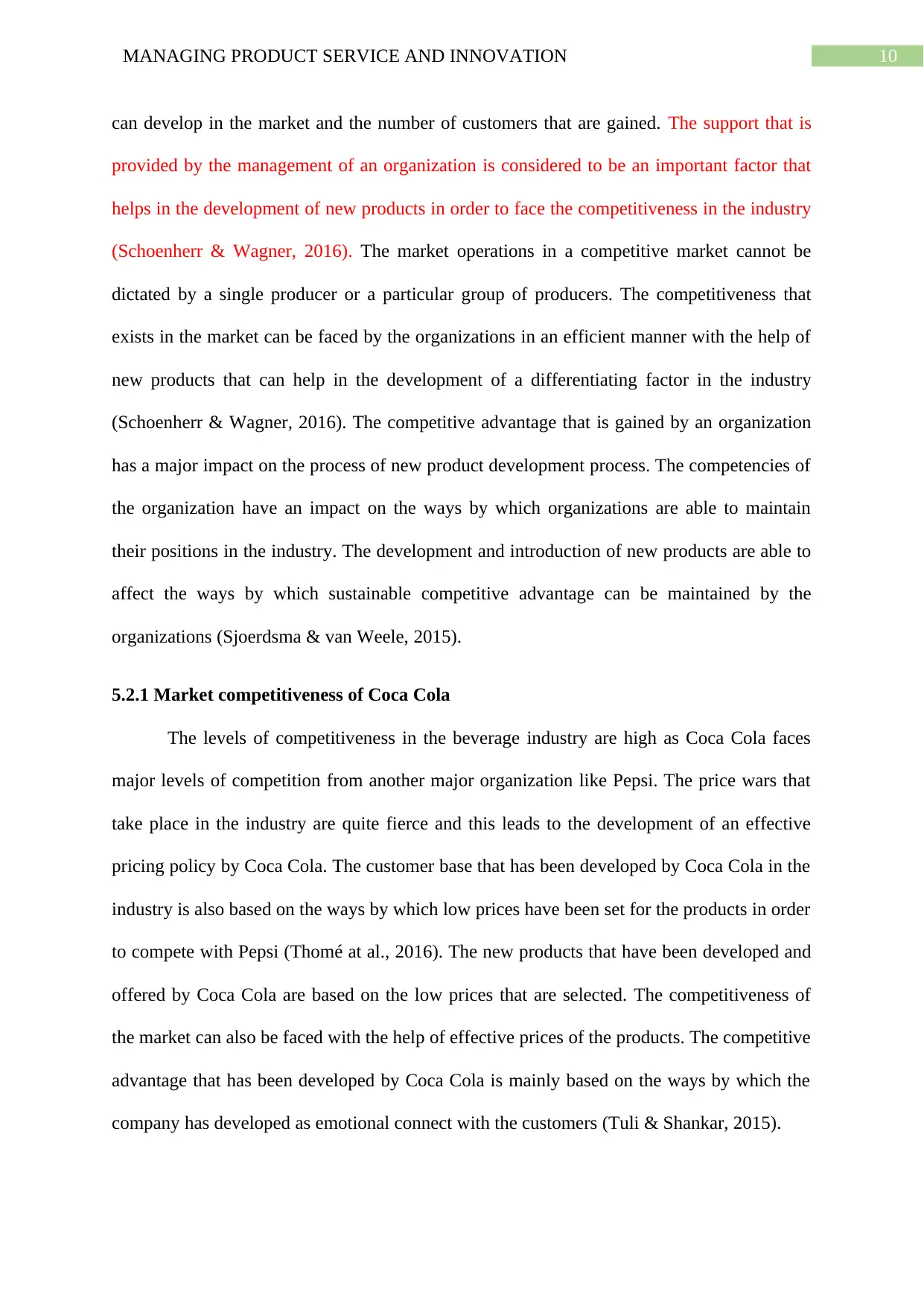
10MANAGING PRODUCT SERVICE AND INNOVATION
can develop in the market and the number of customers that are gained. The support that is
provided by the management of an organization is considered to be an important factor that
helps in the development of new products in order to face the competitiveness in the industry
(Schoenherr & Wagner, 2016). The market operations in a competitive market cannot be
dictated by a single producer or a particular group of producers. The competitiveness that
exists in the market can be faced by the organizations in an efficient manner with the help of
new products that can help in the development of a differentiating factor in the industry
(Schoenherr & Wagner, 2016). The competitive advantage that is gained by an organization
has a major impact on the process of new product development process. The competencies of
the organization have an impact on the ways by which organizations are able to maintain
their positions in the industry. The development and introduction of new products are able to
affect the ways by which sustainable competitive advantage can be maintained by the
organizations (Sjoerdsma & van Weele, 2015).
5.2.1 Market competitiveness of Coca Cola
The levels of competitiveness in the beverage industry are high as Coca Cola faces
major levels of competition from another major organization like Pepsi. The price wars that
take place in the industry are quite fierce and this leads to the development of an effective
pricing policy by Coca Cola. The customer base that has been developed by Coca Cola in the
industry is also based on the ways by which low prices have been set for the products in order
to compete with Pepsi (Thomé at al., 2016). The new products that have been developed and
offered by Coca Cola are based on the low prices that are selected. The competitiveness of
the market can also be faced with the help of effective prices of the products. The competitive
advantage that has been developed by Coca Cola is mainly based on the ways by which the
company has developed as emotional connect with the customers (Tuli & Shankar, 2015).
can develop in the market and the number of customers that are gained. The support that is
provided by the management of an organization is considered to be an important factor that
helps in the development of new products in order to face the competitiveness in the industry
(Schoenherr & Wagner, 2016). The market operations in a competitive market cannot be
dictated by a single producer or a particular group of producers. The competitiveness that
exists in the market can be faced by the organizations in an efficient manner with the help of
new products that can help in the development of a differentiating factor in the industry
(Schoenherr & Wagner, 2016). The competitive advantage that is gained by an organization
has a major impact on the process of new product development process. The competencies of
the organization have an impact on the ways by which organizations are able to maintain
their positions in the industry. The development and introduction of new products are able to
affect the ways by which sustainable competitive advantage can be maintained by the
organizations (Sjoerdsma & van Weele, 2015).
5.2.1 Market competitiveness of Coca Cola
The levels of competitiveness in the beverage industry are high as Coca Cola faces
major levels of competition from another major organization like Pepsi. The price wars that
take place in the industry are quite fierce and this leads to the development of an effective
pricing policy by Coca Cola. The customer base that has been developed by Coca Cola in the
industry is also based on the ways by which low prices have been set for the products in order
to compete with Pepsi (Thomé at al., 2016). The new products that have been developed and
offered by Coca Cola are based on the low prices that are selected. The competitiveness of
the market can also be faced with the help of effective prices of the products. The competitive
advantage that has been developed by Coca Cola is mainly based on the ways by which the
company has developed as emotional connect with the customers (Tuli & Shankar, 2015).
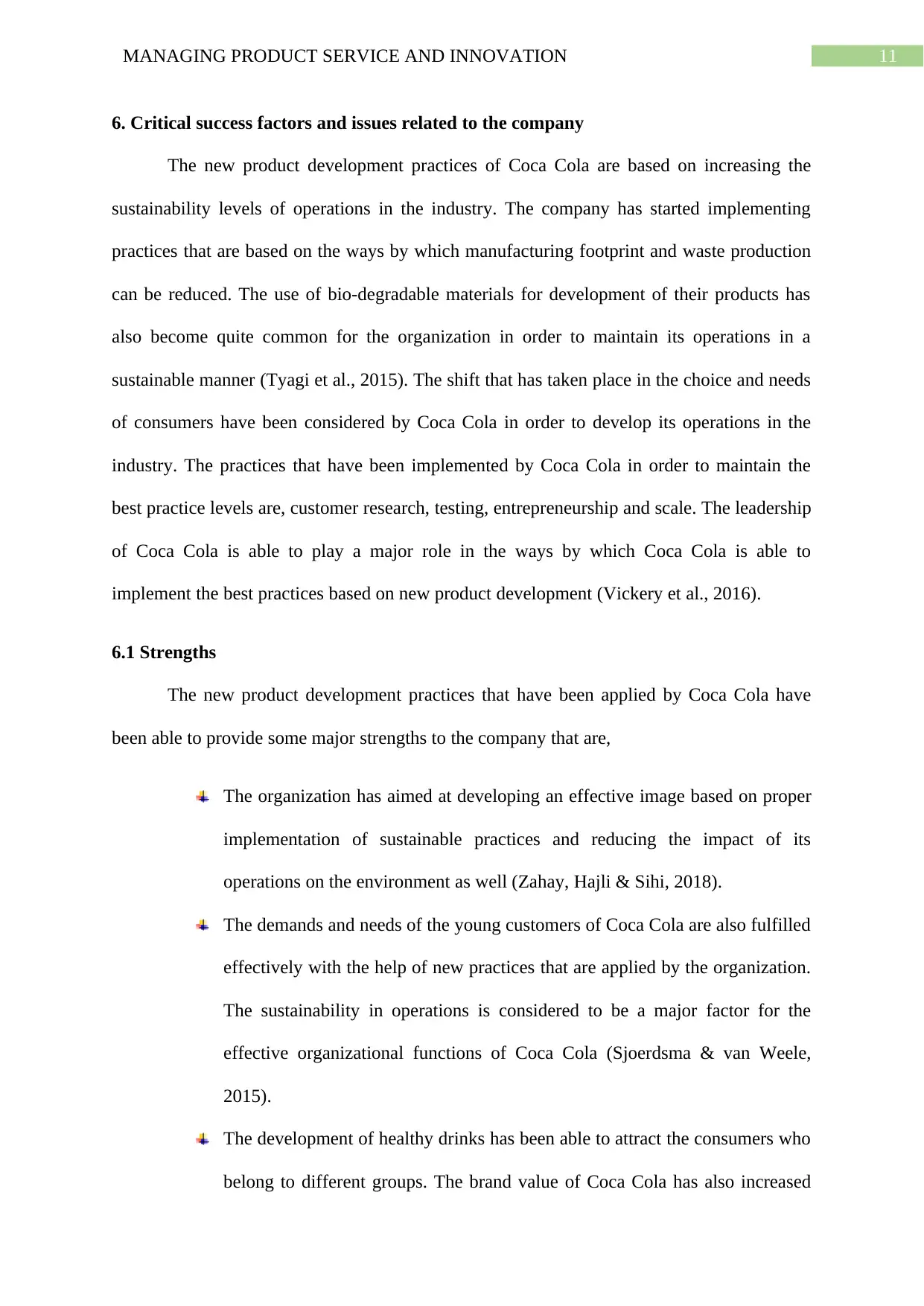
11MANAGING PRODUCT SERVICE AND INNOVATION
6. Critical success factors and issues related to the company
The new product development practices of Coca Cola are based on increasing the
sustainability levels of operations in the industry. The company has started implementing
practices that are based on the ways by which manufacturing footprint and waste production
can be reduced. The use of bio-degradable materials for development of their products has
also become quite common for the organization in order to maintain its operations in a
sustainable manner (Tyagi et al., 2015). The shift that has taken place in the choice and needs
of consumers have been considered by Coca Cola in order to develop its operations in the
industry. The practices that have been implemented by Coca Cola in order to maintain the
best practice levels are, customer research, testing, entrepreneurship and scale. The leadership
of Coca Cola is able to play a major role in the ways by which Coca Cola is able to
implement the best practices based on new product development (Vickery et al., 2016).
6.1 Strengths
The new product development practices that have been applied by Coca Cola have
been able to provide some major strengths to the company that are,
The organization has aimed at developing an effective image based on proper
implementation of sustainable practices and reducing the impact of its
operations on the environment as well (Zahay, Hajli & Sihi, 2018).
The demands and needs of the young customers of Coca Cola are also fulfilled
effectively with the help of new practices that are applied by the organization.
The sustainability in operations is considered to be a major factor for the
effective organizational functions of Coca Cola (Sjoerdsma & van Weele,
2015).
The development of healthy drinks has been able to attract the consumers who
belong to different groups. The brand value of Coca Cola has also increased
6. Critical success factors and issues related to the company
The new product development practices of Coca Cola are based on increasing the
sustainability levels of operations in the industry. The company has started implementing
practices that are based on the ways by which manufacturing footprint and waste production
can be reduced. The use of bio-degradable materials for development of their products has
also become quite common for the organization in order to maintain its operations in a
sustainable manner (Tyagi et al., 2015). The shift that has taken place in the choice and needs
of consumers have been considered by Coca Cola in order to develop its operations in the
industry. The practices that have been implemented by Coca Cola in order to maintain the
best practice levels are, customer research, testing, entrepreneurship and scale. The leadership
of Coca Cola is able to play a major role in the ways by which Coca Cola is able to
implement the best practices based on new product development (Vickery et al., 2016).
6.1 Strengths
The new product development practices that have been applied by Coca Cola have
been able to provide some major strengths to the company that are,
The organization has aimed at developing an effective image based on proper
implementation of sustainable practices and reducing the impact of its
operations on the environment as well (Zahay, Hajli & Sihi, 2018).
The demands and needs of the young customers of Coca Cola are also fulfilled
effectively with the help of new practices that are applied by the organization.
The sustainability in operations is considered to be a major factor for the
effective organizational functions of Coca Cola (Sjoerdsma & van Weele,
2015).
The development of healthy drinks has been able to attract the consumers who
belong to different groups. The brand value of Coca Cola has also increased
⊘ This is a preview!⊘
Do you want full access?
Subscribe today to unlock all pages.

Trusted by 1+ million students worldwide
1 out of 18
Related Documents
Your All-in-One AI-Powered Toolkit for Academic Success.
+13062052269
info@desklib.com
Available 24*7 on WhatsApp / Email
![[object Object]](/_next/static/media/star-bottom.7253800d.svg)
Unlock your academic potential
Copyright © 2020–2025 A2Z Services. All Rights Reserved. Developed and managed by ZUCOL.




